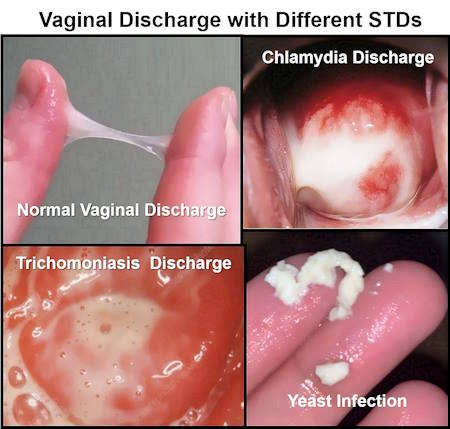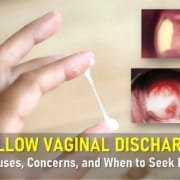Vaginal Discharge with Different STDs: Key Signs You Shouldn’t Ignore
Vaginal discharge is a natural bodily function that helps maintain a healthy vaginal environment by flushing out old cells and bacteria. While it is usually normal, changes in the color, consistency, or smell of discharge may signal an underlying issue, including sexually transmitted diseases (STDs). Understanding the difference between normal and abnormal discharge can help you recognize potential warning signs of infection.
Since vaginal discharge can vary from person to person, factors like menstrual cycles, birth control use, and sexual activity can influence its appearance. If you’ve ever wondered, “What does STD discharge look like?” or whether changes in your discharge indicate an infection, this article will provide you with essential information.
What Is Normal Vaginal Discharge?
Before discussing STDs and abnormal discharge, it’s important to understand what’s considered normal. Vaginal discharge varies in amount, texture, and color throughout the menstrual cycle due to hormonal fluctuations. While every woman’s body is different, there are general characteristics of healthy vaginal discharge.
Characteristics of Normal Vaginal Discharge
- Texture: It can range from watery and slippery to thick and sticky, changing throughout the cycle.
- Amount: Some women naturally produce more discharge than others. Factors like ovulation, pregnancy, and birth control use can influence the quantity.
- Color: Normal discharge is usually clear or white.
- Odor: While vaginal discharge has a mild scent, it should not be foul-smelling or overwhelming.
Changes in Vaginal Discharge Throughout the Menstrual Cycle
The appearance and consistency of vaginal discharge can change throughout your menstrual cycle due to hormonal fluctuations. Here’s what to expect during each phase:
- During menstruation (days 1-5): Discharge is minimal or mixed with blood as the body sheds the uterine lining.
- Follicular phase (after menstruation to ovulation): Discharge becomes clearer and more slippery, preparing the body for ovulation.
- During ovulation (around day 14): Discharge is clear, stretchy, and resembles egg whites, making it easier for sperm to travel.
- Luteal phase (after ovulation to your period): Discharge thickens and becomes creamier due to increased progesterone levels.
These changes are a normal part of your body’s reproductive cycle. However, if your discharge looks unusual, has a strong odor, or causes discomfort, it’s a good idea to consult a healthcare provider to rule out any underlying issues.
Abnormal Vaginal Discharge and STDs
While vaginal discharge is usually normal, a sudden change in its color, texture, amount, or odor could indicate an infection. Many STDs can alter vaginal discharge, making it an important symptom to pay attention to.
However, not all abnormal discharge is caused by STDs. Two common non-STD conditions, yeast infections and bacterial vaginosis, can also lead to changes in discharge. These conditions are often triggered by:
- Antibiotic or steroid use
- Frequent douching, scented soaps, or bubble baths
- Hormonal contraceptives
- A new sexual partner

Vaginal Discharge with Different STDs
While some STDs cause noticeable vaginal discharge changes, many infections remain asymptomatic. Below, we explore common STDs that affect vaginal discharge and their key characteristics.
Chlamydia and Vaginal Discharge
Chlamydia is one of the most frequently diagnosed STDs, particularly among young women. However, it often goes unnoticed because many women do not experience symptoms. If left untreated, chlamydia can lead to serious reproductive health issues, including infertility.
Common Symptoms of Chlamydia
- Unusual vaginal discharge
- Pain during urination
- Bleeding after intercourse
- Irregular bleeding between periods
- Lower abdominal or pelvic pain
What Does STD Discharge Look Like with Chlamydia?
- Amount: Typically minimal
- Color: Yellow, gray, or white
- Consistency: Mucous-like or milky
- Odor: Often has a strong smell
Since chlamydia is often asymptomatic, regular STD testing is crucial for sexually active individuals, especially young women. For more information see “Chlamydia: Causes, Symptoms, Treatment & Prevention“.
Vaginal Discharge with Gonorrhea
Gonorrhea is a bacterial STD that often goes unnoticed in women. In fact, 80% of infected females experience no symptoms, making regular testing crucial. When symptoms do occur, they typically appear 3 to 7 days after infection.
Common Gonorrhea Symptoms
- Unusual vaginal discharge
- Painful urination
- Bleeding after intercourse
- Irregular bleeding between periods
- Pelvic pain
What Does STD Discharge Look Like with Gonorrhea?
- Color: Yellowish with a green hue
- Amount: Often abundant
- Consistency: Thick
- Odor: Usually odorless
For more information about Gonorrhea see “Gonorrhea: Symptoms, Treatment & Prevention“.
Vaginal Discharge with Trichomoniasis
Unlike chlamydia and gonorrhea, trichomoniasis (often called “trich”) is more common in older women. Although it has fewer complications, it increases the risk of contracting other STDs.
Only 30% of trichomoniasis cases produce symptoms, which may take 5 to 28 days to appear.
Common Trichomoniasis Symptoms
- Unusual vaginal discharge
- Vaginal itching and burning
- Vaginal swelling
- Painful urination
- Pain during sex
What Does STD Discharge Look Like with Trichomoniasis?
- Color: Yellowish-green
- Amount: Abundant
- Consistency: Thin, watery, sometimes frothy (filled with tiny bubbles)
- Odor: Strong, fishy smell
For more details see “Trichomoniasis (Trich): Causes, Symptoms, Diagnosis & Treatment“.
Vaginal Discharge with Mycoplasma Genitalium (MG)
Mycoplasma genitalium (MG) is an STD as common as chlamydia. It often coexists with other infections, such as bacterial vaginosis, gonorrhea, or chlamydia, making it difficult to diagnose.
MG is not commonly tested for, yet it can cause serious complications, including pelvic inflammatory disease (PID) and infertility.
Only 15% of MG cases present with symptoms, which may take 2 to 28 days to appear.
Common Mycoplasma Symptoms
- Unusual vaginal discharge
- Vaginal itching
- Burning sensation during urination
- Painful intercourse
- Lower abdominal or pelvic pain
What Does STD Discharge Look Like with Mycoplasma?
- Color: Yellowish-green (sometimes whitish)
- Amount: Minimal
- Consistency: Thin, watery
- Odor: Fishy smell (especially if coexisting with bacterial vaginosis or chlamydia)
For more details see “Mycoplasma Genitalium (Mgen): Symptoms, Causes & Treatment“.
When Vaginal Discharge Is Not an STD
Not all unusual vaginal discharge is caused by an STD. Yeast infections and bacterial vaginosis (BV) are two common non-STD conditions that cause abnormal discharge.
While sex can trigger these conditions, they are not transmitted from a sexual partner. This means partners do not need testing or treatment.
Vaginal Discharge with a Yeast Infection (Candidiasis)
A yeast infection (vaginal candidiasis) is a common condition that affects 3 out of 4 women at some point in their lifetime. Many women experience multiple episodes.
While up to 20% of yeast infections are asymptomatic, recognizing changes in vaginal discharge can help with early detection.
Common Yeast Infection Symptoms
- Vaginal itching
- Pain during sex
- Burning sensation during urination
- Unusual vaginal discharge
What Does Yeast Infection Discharge Look Like?
- Amount: Slight increase in discharge
- Color: White
- Consistency: Thick, clumpy (often described as “cottage cheese”)
- Odor: Usually odorless but may smell like yeast or bread (sometimes slightly foul-smelling)
For more details read, “Vaginal Yeast Infections: Symptoms, Causes and Treatment“.
Vaginal Discharge with Bacterial Vaginosis (BV)
Bacterial vaginosis (BV) is a very common vaginal condition, affecting 1 in 3 women in the U.S. at least once in their lifetime.
Between 50% to 75% of women with BV experience no symptoms. However, untreated BV can increase the risk of contracting STDs such as HIV, herpes, chlamydia, and gonorrhea.
Common Bacterial Vaginosis Symptoms
- Vaginal pain, itching, or burning
- Burning sensation during urination
- Significant vaginal discharge with a strong odor
What Does BV Discharge Look Like?
- Amount: Large volume
- Color: White or gray
- Consistency: Thin
- Odor: Strong, fishy smell
For more details see “Bacterial Vaginosis: Causes, Symptoms, and Treatments“.
When to Seek Medical Help
It’s important to monitor vaginal discharge changes and seek medical attention if you notice:
- Persistent abnormal discharge
- A strong, unpleasant odor
- Burning, itching, or pain in the vaginal area
- Pelvic pain
- Unusual bleeding
If you suspect an STD, getting tested promptly can help prevent complications and protect your reproductive health.
When Vaginal Discharge Is Possible but Not Common
Some STDs, such as genital herpes and genital warts (HPV), can cause vaginal discharge, but it’s less frequent than with infections like chlamydia, gonorrhea, trichomoniasis, and mycoplasma. Non-STD causes, such as bacterial vaginosis (BV) and yeast infections, are also more common triggers of abnormal discharge.
Herpes Discharge
Genital herpes is a widespread STD that affects women more than men. Around 1 in 5 females has genital herpes, compared to 1 in 10 males. Women are at greater risk due to their anatomy, as the increased vaginal mucosa makes transmission easier.
Most women with genital herpes—between 75% and 90%—are unaware they have it because they never develop symptoms.
For those who do experience symptoms, the incubation period ranges from 2 to 12 days, with an average of 4 days. Although herpes is a lifelong condition, it does not cause serious health complications or reduce life expectancy.
Symptoms of a Herpes Outbreak
- Tingling, burning, or mild itching before sores appear
- Formation of blisters that burst and leave open sores
- Significant pain (rated 7/10) during the blister and sore stages
- Possible scanty vaginal discharge
What Does Herpes Discharge Look Like?
- Amount: Minimal, short-lived
- Color: Transparent
- Consistency: Watery
- Odor: Odorless unless another infection is present
For more information see “Genital Herpes: Symptoms, Pictures, and Medication“.
HPV Discharge
Human papillomavirus (HPV) is the most common STD, affecting about 80% of women at some point in their lifetime.
Like herpes, most women don’t realize they have HPV because it’s usually asymptomatic. In 90% of cases, the immune system clears the virus on its own.
For those whose HPV persists, it may present as genital warts (small bumps in the genital area) or cervical dysplasia (abnormal precancerous cells detected during a Pap smear).
Some high-risk HPV strains can lead to cervical cancer if left untreated. Unfortunately, early cervical cancer has no symptoms, but HPV-related signs may include:
- Bleeding between menstrual periods
- Longer and heavier menstrual periods
- Pelvic pain
- Pain during sex
What Does HPV Discharge Look Like?
- Amount: Slightly increased
- Color: Pale, pink, brown, or bloody
- Consistency: Regular
- Odor: Can range from no smell to a foul odor
For more details about Human Papillomavirus (HPV) Infection read “Human Papillomavirus (HPV) Infection: Symptoms and Prevention”
What to Do About Abnormal Vaginal Discharge
If you notice unusual vaginal discharge for the first time, it’s important to see a doctor as soon as possible—especially if you also have:
- Pain or increased frequency of urination
- Bleeding after intercourse
- Bleeding between periods
- Fever and chills
- Unexplained weight loss
- Lower abdominal pain
Vaginal Discharge: Diagnosis of the Cause
Understanding the History
Doctors start by evaluating possible causes based on a patient’s history. They may ask about:
- Recent sexual activity (new partner, open relationships)
- Recent antibiotic or steroid use
- Use of oral contraceptives
- History of douching
Vaginal pH Test
Checking vaginal pH levels can help narrow down the cause:
- pH < 4.5: Normal discharge or yeast infection
- pH > 5: Possible trichomoniasis or bacterial vaginosis
Vaginal Swabs for Common STDs
If an STD is suspected, a vaginal swab may be taken to test for:
- Chlamydia
- Gonorrhea
- Trichomoniasis
- Mycoplasma
- Bacterial vaginosis
- Yeast infection
Further Testing
- If initial tests are negative, further testing for ureaplasma may be done.
- If blisters or sores are present, a herpes swab test can confirm herpes.
- If HPV is suspected, a Pap smear can detect abnormal cervical cells.
Common Treatments for Vaginal Discharge
Treatment depends on the cause of the discharge. Some conditions can be managed with over-the-counter medication, while others require a prescription.
Yeast Infection (Candidiasis) Treatment
- Over-the-counter: Miconazole (Monistat), Tioconazole (Vagistat), Clotrimazole (Gyne-Lotrimin)
- Prescription: Fluconazole (Diflucan) 150 mg, taken as a one-time dose
Bacterial Vaginosis (BV) Treatment
- Prescription: Metronidazole (oral or vaginal gel), Clindamycin vaginal cream
Trichomoniasis Treatment
- Prescription: Metronidazole (Flagyl), taken as a single dose or for seven days
Chlamydia Treatment
- Prescription: Doxycycline or azithromycin
Gonorrhea Treatment
- Prescription: A one-time ceftriaxone shot at a doctor’s office
Mycoplasma Genitalium Treatment
- Prescription: A combination of doxycycline (7 days) and moxifloxacin (7 days) due to antibiotic resistance
Ureaplasma Treatment
- Prescription: Doxycycline for 10 days
Frequently Asked Questions
What Does STD Discharge Look Like?
STD-related vaginal discharge can vary in color, consistency, and smell. It may be yellow, green, gray, or white and often has a foul odor. The texture can be watery, frothy, or thick, depending on the infection. If you notice unusual discharge along with itching, pain, or bleeding, it’s best to get tested.
What Are most Common Symptoms of an STD?
STDs can cause a range of symptoms, but five common signs include:
- Unusual vaginal discharge
- Pain or burning during urination
- Itching, sores, or blisters around the genitals
- Pelvic pain or discomfort during intercourse
- Unexplained bleeding between periods
Not all STDs show symptoms right away, so regular testing is crucial.
What Color Is STD Discharge in Females?
The color of STD-related vaginal discharge varies depending on the infection:
- Yellow or green: Common with gonorrhea or trichomoniasis
- Gray or white: Often linked to bacterial vaginosis
- Brown or bloody: May indicate HPV-related cervical changes
- Frothy with a strong odor: Can be a sign of trichomoniasis
If you notice any of these changes, seek medical advice.
How Can a Female Tell If She Has an STD?
The only way to confirm an STD is through testing, but symptoms like abnormal vaginal discharge, burning during urination, genital sores, pelvic pain, and irregular bleeding could be signs of an infection. If you have had unprotected sex or suspect exposure to an STD, get tested as soon as possible.
Can Vaginal Discharge Be the Only Symptom of an STD?
Yes, in some cases, vaginal discharge may be the only noticeable symptom of an STD, especially in infections like chlamydia, gonorrhea, and trichomoniasis. Since some STDs are asymptomatic, routine testing is the best way to stay informed about your sexual health.
Does All Vaginal Discharge Mean an Infection?
No, vaginal discharge is normal and helps keep the vagina clean. However, if you notice a sudden change in color, consistency, smell, or experience symptoms like itching, pain, or burning, it may indicate an infection that requires medical attention.
Final Thoughts
Recognizing abnormal vaginal discharge and understanding its potential causes can help you take control of your reproductive health. Whether it’s an STD or a non-STD infection, seeking early diagnosis and treatment is essential. If you’re unsure about your symptoms, consult a healthcare provider for the right guidance and care.










